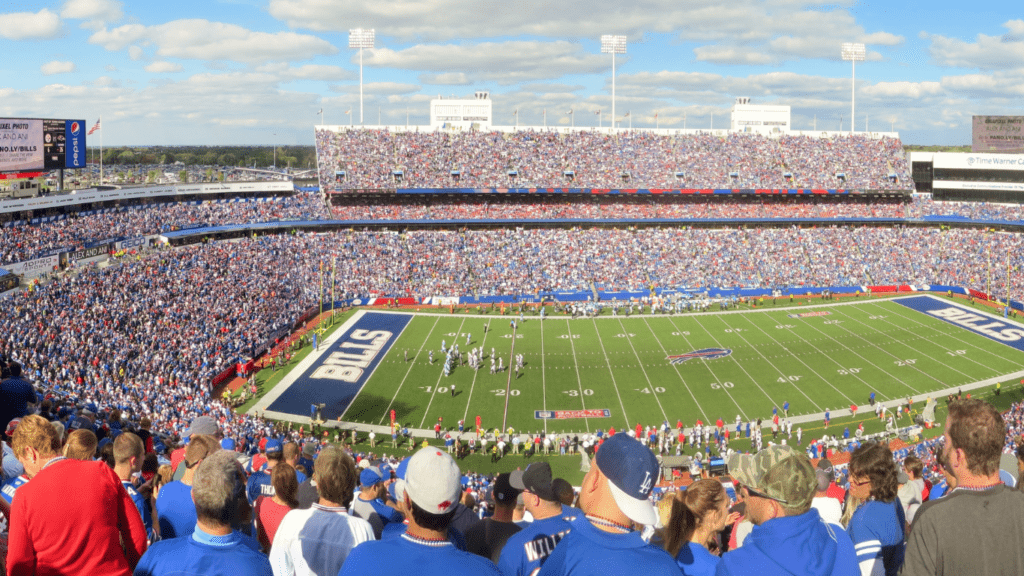Understanding Sustainability in Sports
Sustainability in sports involves adopting practices that reduce environmental impact. Teams and brands focus on several key areas to achieve this goal. Eco-friendly stadiums, for instance, use recyclable materials in construction and implement energy-efficient systems. Events often feature waste reduction programs like:
- recycling
- composting
- reusable containers
Another focus is sustainable merchandise. Brands partner with teams to produce eco-conscious apparel. Examples include jerseys made from recycled plastics and organic cotton, minimizing water and pesticide use. These products offer fans greener alternatives.
Energy investment also plays a significant role. Teams adopt renewable sources, such as solar panels and wind turbines, to power facilities. Energy-efficient lighting and HVAC systems further reduce carbon footprints. These efforts contribute to significant long-term sustainability goals.
Transportation initiatives are increasingly common. Teams encourage fans to use public transit or carpool. Some organizations partner with ride-sharing apps to offer discounts. Electric vehicle charging stations in stadium parking lots incentivize greener travel.
Fan engagement is crucial. Teams educate supporters on sustainability practices through campaigns and events. Programs sometimes feature interactive exhibits or green-themed games, fostering a community commitment to eco-friendly practices.
Sustainability in sports isn’t merely a trend. It’s a commitment influencing the entire industry, setting a benchmark for environmental responsibility that fans and organizations embrace.
Importance of Going Green in Sports
Sustainability in sports isn’t just a trend; it’s critical for the industry’s future. Sports teams and brands play a major role in society, and their environmental actions can set a powerful example. When they adopt green initiatives, they influence fans to make eco-friendly choices in their own lives. This ripple effect significantly amplifies the impact of any single sustainable action.
Environmental responsibility reduces operational costs. Energy-efficient stadiums, for example, lower utility bills over time. Waste reduction programs minimize disposal expenses. Brands and teams can reinvest these savings in further sustainability efforts or other strategic areas.
Sustainability attracts sponsors and investors. Companies increasingly prefer to align with entities committed to environmental responsibility. By going green, sports teams and brands can unlock new sponsorship opportunities and partnerships with eco-conscious businesses. This not only boosts their financial health but also reinforces their commitment to a broader audience.
Sports events draw substantial crowds, leading to significant carbon emissions and waste. By embracing green practices, teams and organizers can drastically reduce this footprint. For example, using renewable energy for events, offering recycling and composting at venues, and encouraging public transportation and carpooling can make a notable difference.
Fan engagement in sustainability fosters community. Teams can educate supporters on environmental issues through campaigns, interactive events, and partnerships with ecological organizations. These efforts raise awareness and cultivate a culture of sustainability among fans, extending environmental benefits beyond the stadium.
Going green enhances brand image and loyalty. Teams and brands perceived as environmentally responsible often enjoy stronger support and a more dedicated fanbase. Fans appreciate and respect entities that prioritize the planet, which increases their emotional and financial investment in these organizations. This loyalty translates to a competitive advantage in a crowded market.
Overall, adopting sustainable practices is essential for sports teams and brands. It’s not just about reducing environmental harm; it’s about setting an industry standard, engaging communities, attracting investment, and ensuring long-term success.
Teams Leading the Sustainability Movement
Sports teams across levels are pioneering efforts to reduce environmental impact, serve as role models, and inspire fans.
Professional Sports Teams
Professional sports teams are at the forefront of sustainability initiatives. The Seattle Kraken, for example, implemented the “Green Pledge” in their Climate Pledge Arena by adopting zero-emission technologies and sourcing 100% renewable energy. The Los Angeles Lakers introduced comprehensive recycling programs throughout the Staples Center and installed water-saving fixtures, reducing their water usage significantly. In the UK, Forest Green Rovers became the world’s first carbon-neutral soccer club by integrating electric vehicles and building their stadium from sustainable materials.
Collegiate Sports Teams
Collegiate sports teams are also making notable strides towards sustainability. Ohio State University’s athletic department invested in solar panels, which now power over 30% of their sports facilities, and introduced extensive composting programs to minimize food waste. Stanford University’s initiatives include the “Cardinal Green” program, which promotes energy conservation, rigorous recycling practices, and FSC-certified paper merchandise. The University of Colorado Boulder implemented a zero-waste program during their football games, achieving an impressive 90% waste diversion rate.
Teams’ sustainability efforts are reshaping the industry. These initiatives not only reduce environmental impact and operational costs, but also inspire fans to adopt greener practices.
Brands Championing Sustainability
Several prominent brands are leading the charge in making the sports industry more environmentally friendly. These entities recognize the importance of sustainability and are adopting practices that reduce their ecological footprint.
Apparel and Equipment Manufacturers
Many apparel and equipment manufacturers are embracing sustainable practices. Adidas, for example, launched its “Parley for the Oceans” line, which uses recycled ocean plastic to create shoes and clothing. Nike introduced the “Move to Zero” campaign, aiming for zero carbon and zero waste across its products. Puma joined the trend with its “Forever Better” initiative, focusing on sustainable materials and energy-efficient production processes. These brands not only produce eco-friendly gear but also promote sustainability through marketing and collaborations with athletes and teams.
Beverage and Food Sponsors
Beverage and food sponsors are also getting on board with sustainability. Coca-Cola, an official partner of numerous sports events, committed to collecting and recycling one bottle or can for every one sold by 2030. PepsiCo announced its goal to make 100% of its packaging recyclable, compostable, or biodegradable by 2025. Gatorade is exploring reusable containers in partnership with teams to reduce single-use plastic waste. These sponsors support sustainability by launching green initiatives and leveraging sports events to raise environmental awareness.
Innovations and Practices Promoting Sustainability

Various innovations and practices in the sports industry promote sustainability by targeting different aspects of operations.
Stadium and Facility Management
Teams are integrating sustainable methods into stadium and facility management. Many new stadiums use recycled materials in construction and design elements, reducing the need for virgin resources. Energy-efficient systems, like LED lighting and advanced HVAC, minimize energy consumption. For instance, the Mercedes-Benz Stadium in Atlanta uses both solar panels and rainwater capture systems to promote resource efficiency. Water conservation is a key focus, with on-site water recycling initiatives and low-flush systems helping to reduce usage.
Sustainable Transportation and Travel
- Transportation contributes significantly to a team’s carbon footprint.
- Many sports teams now offer incentives for fans to use public transportation or cycle to events.
- Electric vehicle (EV) charging stations in stadium parking lots encourage the use of eco-friendly vehicles.
- Collaborations with car-sharing services further reduce traffic and emissions.
- Teams like the New York Yankees provide discounted tickets to fans who use public transit, enhancing the appeal of eco-friendly travel options.
- For team travel, many franchises are opting for energy-efficient buses and carbon offset programs to mitigate the environmental impact of air travel.
Challenges Facing Sustainability in Sports
Implementing sustainability in sports meets several obstacles. One major issue is the high initial investment. Green technologies, such as solar panels and energy-efficient systems, require significant upfront costs. Although these investments reduce long-term operational costs, the sizable initial outlay can be a barrier for many teams.
Another challenge is waste management during large events. Sports stadiums generate enormous amounts of waste in a short time, making it vital to implement efficient recycling and composting systems. However, not all facilities have the infrastructure or resources to handle this effectively.
Transportation is a complex problem. Fans traveling to and from events contribute heavily to a team’s overall carbon footprint. Encouraging public transit or providing electric vehicle charging stations requires extensive planning and coordination with local governments and transit systems, posing logistical issues.
Sourcing sustainable materials also presents difficulties. While brands aim to create eco-friendly merchandise, finding reliable suppliers of recycled materials and organic cotton can be challenging. Inconsistencies in supply chains disrupt production, affecting the availability of sustainable products.
Regulations and policies vary widely across regions. Teams operating in different jurisdictions face inconsistent regulations, complicating the implementation of uniform sustainability practices. Navigating these varied legal landscapes demands additional resources and time.
Engaging fans in sustainability initiatives is crucial but difficult. Although many fans support environmental causes, motivating them to change behaviors, like reducing waste or using public transit, requires constant effort. Effective campaigns demand creativity and sustained engagement.
Lastly, there’s the challenge of balancing performance goals with sustainability. Teams and brands often prioritize winning and profitability. Integrating green practices without compromising competitive performance or financial stability is a delicate balancing act.
These challenges underscore the complexity of promoting sustainability in sports. Effective solutions demand collaboration, innovation, and long-term commitment.
The Future of Green Sports
Sustainability’s integration into sports promises a transformative future. Teams and brands continue embracing eco-friendly innovations that can reshape the industry. New stadiums will likely combine sustainable architecture with cutting-edge technology to minimize environmental impact. Facilities using materials like recycled steel and eco-friendly concrete will set the standard. Energy efficiency will remain a focal point, with advancements in solar and wind energy adoption.
Sustainable merchandise will evolve, driven by advancements in material science. Brands may innovate with biodegradable materials and fabric recycling technologies. Future apparel lines will prioritize minimal environmental impact without compromising performance. Expect collaborations between fashion and sports brands to yield even more eco-conscious products.
Renewable energy investments in sports will increase. More teams will choose solar farms and wind turbines to power operations. Facilities might even become energy positive, generating more power than they consume. Such strides can significantly reduce the industry’s carbon footprint.
Transportation initiatives will advance, promoting eco-friendly travel for fans. Expect enhancements in public transit integrations and increased support for electric vehicles. Teams might incorporate more incentives for fans using sustainable transportation, further reducing collective emissions.
Fan engagement in sustainability will deepen. Interactive campaigns and digital platforms can educate and inspire. Virtual reality experiences could immerse fans in the environmental impacts of their actions, fostering a stronger connection to green initiatives.
Challenges remain, but innovation and commitment will drive progress. The future of green sports is bright, paving the way for a more sustainable industry.



